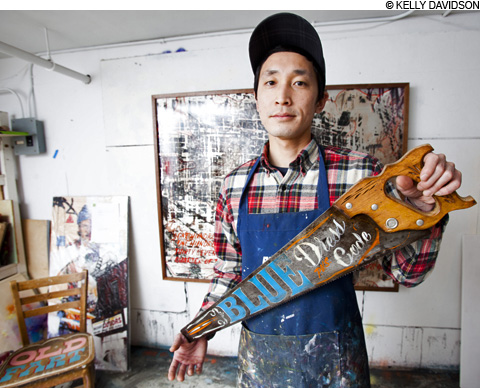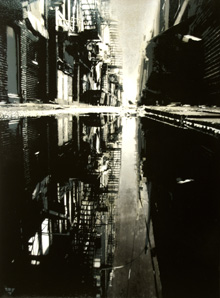
ART AND CRAFT Kenji Nakayama came to Boston to learn the vanishing craft of sign-painting. He’s become a Boston art-world phenomenon. |
This winter, the Butera School of Art in Back Bay commences its last-ever sign-making classes, teaching students how to hand-letter everything from yachts to mom-and-pop shops. The closing of the program wraps a century-old legacy for the school, which was acquired by Fisher College two years ago, and soon after was slated for shuttering. A proudly practical career institute, Butera's longstanding mission was to "raise artists to make a living with their art talents, and their art talents alone." It was the last of its kind on the East Coast. Only LA Trade Tech in California offers comparable formal training.
>> PHOTOS: Kenji Natayama's work <<
For someone like Kenji Nakayama, whose art career began in the school's Beacon Street sign shop, the fate of Butera signals more than just a sad end for his alma mater, which he moved more than 7000 miles from Japan to attend eight years ago. It also caps an era that the soft-spoken, kind-hearted prodigy pines for, and that he works daily to preserve in some form or another — a time in which commercial art had character, and city streets were outfitted with mundane masterpieces rather than generic molds and plastic placards.
"Hand-painted letters aren't perfect, but they have character," says Nakayama, whose lab is in the South Boston creative complex the Distillery. Though he speaks in short sentences and broken English, he clearly communicates his passion for throwback banners and rustic awnings. "I always wanted to create things by hand, and now I want to keep the craft going. One day, if what I'm doing inspires other, younger people to do things this way, I would be really happy. I like craft culture, and if people stop paying attention, it will die."

REFLECTION RETURNAL (2007) Nakayama’s photo-realist street scenes are often created with multiple layers of hand-cut stencils, spray paint, and enamel. |
While at Butera in the mid-2000s, Nakayama was encouraged by a teacher there to pursue an interest in cityscapes, which the young artist began to illustrate with spray paint and sophisticated stencils in a photo-realist fashion that's since become one of his hallmarks. His mixed-media technique evolved to include aerosol, enamel, acrylic and other materials on a variety of boards and canvas. After those epic scenes of sidewalks and fire escapes started selling in edgier Boston galleries, Nakayama seized the opportunity to expand his scope, but never lost focus of what lured him to the States.A former precision-parts engineer, Nakayama is now riding a wildly different career trajectory than he imagined in his native Tomakomai, on the island of Hokkaido. Yet at 32 — less than a decade after switching careers — he's already widely revered for his determination to keep authentic sign culture kicking. This month he's exhibiting at the Guerrero Gallery in San Francisco (the show is called "An American Language"); new sign projects are in the works for a two-man show with his studio-mate Dana Woulfe at Boston's Lot F Gallery in April; the following month, he has his first major Manhattan solo outing at the Woodward Gallery.